
The Majestic Wonder of Iguazu Falls National Park
Discover the awe-inspiring Iguazu Falls National Park in Brazil, a UNESCO World Heritage site showcasing stunning waterfalls, rich biodiversity, and unforgettable adventures.
Iguazu Falls National Park in Brazil is a breathtaking natural wonder that captivates all who visit. The park is home to one of the world's most impressive waterfall systems, with over 275 individual falls cascading along the Iguazu River. The thunderous roar and misty spray from the falls create a mesmerizing spectacle that leaves visitors in awe. The surrounding lush rainforest is teeming with diverse wildlife, including colorful birds, playful monkeys, and elusive jaguars. Visitors can explore the park through a network of well-maintained trails and walkways that offer stunning views of the falls from various vantage points. The Devil's Throat, the largest and most dramatic of the falls, is a must-see highlight. A boat ride to the base of the falls provides an exhilarating experience, allowing tourists to feel the power of the water up close. The park also offers various other activities, such as bird watching, hiking, and guided tours that delve into the rich history and ecology of the area. Iguazu Falls National Park is not just about the falls; it is also a UNESCO World Heritage site that plays a crucial role in conservation. The park's efforts to preserve its unique biodiversity make it a haven for nature lovers and eco-tourists. Whether you are seeking adventure, tranquility, or simply the chance to witness one of nature's greatest spectacles, Iguazu Falls National Park promises an unforgettable experience.
Local tips in Iguazu Falls National Park
- Visit early in the morning to avoid the crowds and enjoy the falls in peace.
- Wear waterproof clothing or bring a raincoat, as the mist from the falls can leave you soaked.
- Don't forget insect repellent; the rainforest is home to many insects.
- Bring a good pair of walking shoes for the park's trails and walkways.
- Consider visiting during the rainy season (December to March) for the most powerful water flow.
The Majestic Wonder of Iguazu Falls National Park
Iguazu Falls National Park in Brazil is a breathtaking natural wonder that captivates all who visit. The park is home to one of the world's most impressive waterfall systems, with over 275 individual falls cascading along the Iguazu River. The thunderous roar and misty spray from the falls create a mesmerizing spectacle that leaves visitors in awe. The surrounding lush rainforest is teeming with diverse wildlife, including colorful birds, playful monkeys, and elusive jaguars. Visitors can explore the park through a network of well-maintained trails and walkways that offer stunning views of the falls from various vantage points. The Devil's Throat, the largest and most dramatic of the falls, is a must-see highlight. A boat ride to the base of the falls provides an exhilarating experience, allowing tourists to feel the power of the water up close. The park also offers various other activities, such as bird watching, hiking, and guided tours that delve into the rich history and ecology of the area. Iguazu Falls National Park is not just about the falls; it is also a UNESCO World Heritage site that plays a crucial role in conservation. The park's efforts to preserve its unique biodiversity make it a haven for nature lovers and eco-tourists. Whether you are seeking adventure, tranquility, or simply the chance to witness one of nature's greatest spectacles, Iguazu Falls National Park promises an unforgettable experience.
When is the best time to go to Iguazu Falls National Park?
Iconic landmarks you can’t miss
Iguazu Falls
Explore the breathtaking Iguazu Falls, a UNESCO World Heritage site, where cascading waters and vibrant wildlife create an unforgettable natural spectacle.

Parque das Aves
Experience the vibrant avian paradise of Parque das Aves, a breathtaking sanctuary near Iguazu Falls, showcasing exotic birds and nature conservation.

Hito Tres Fronteras
Discover the breathtaking views and cultural significance at Hito Tres Fronteras, where Argentina, Brazil, and Paraguay meet in stunning harmony.

Visitor Center Station
The Visitor Center Station is the ultimate starting point for exploring the breathtaking Iguaçu Falls, offering essential information and stunning views.

Lookout Devil's Throat
Explore the breathtaking views and awe-inspiring power of Devil's Throat, a highlight of Iguaçu Falls, where nature's beauty takes center stage.

La Aripuca
Explore La Aripuca in Puerto Iguazú: A stunning ecological park showcasing nature and indigenous culture for an unforgettable experience.

Iguaçu National Park
Explore the breathtaking beauty of Iguaçu National Park, a UNESCO World Heritage site known for its stunning waterfalls and rich biodiversity in Brazil.

Macuco Safari
Discover the breathtaking beauty of Iguaçu Falls with Macuco Safari, an unforgettable adventure in the heart of nature's wonders.

Cataratas do Iguaçu - Brasil
Experience the breathtaking beauty and power of nature at Cataratas do Iguaçu, a UNESCO World Heritage site and one of the largest waterfall systems in the world.

Caminho das Cataratas Brasil
Discover the breathtaking beauty of Caminho das Cataratas in Foz do Iguaçu, where stunning views of the iconic Iguazu Falls await.

Bourbon Cataratas do Iguaçu Thermas Eco Resort
Experience luxury and nature at the Bourbon Cataratas do Iguaçu Thermas Eco Resort, your gateway to the breathtaking Iguaçu Falls.

Hotel das Cataratas, A Belmond Hotel, Iguassu Falls
Discover the ultimate luxury experience at Hotel das Cataratas, the only hotel within breathtaking Iguazu Falls National Park, blending adventure with relaxation.

Paseos de Luna Llena en las Cataratas del Iguazú
Discover the breathtaking Iguazu Falls illuminated by the full moon, a magical experience that reveals the falls' beauty like never before.

Garganta Del Diablo
Experience the breathtaking power of nature at Garganta Del Diablo, the stunning heart of Iguazu Falls in Argentina's Misiones Province.

Parque Nacional do Iguaçu
Immerse yourself in the stunning beauty of Parque Nacional do Iguaçu, home to the breathtaking Iguaçu Falls and rich biodiversity.

Unmissable attractions to see
Hito Tres Fronteras
Experience the breathtaking convergence of Argentina, Brazil, and Paraguay at Hito Tres Fronteras, a must-visit viewpoint in Puerto Iguazú, Argentina.

Lookout Devil's Throat
Experience the breathtaking beauty of Devil's Throat Lookout at Iguaçu Falls, a must-visit natural wonder in Brazil's stunning landscape.
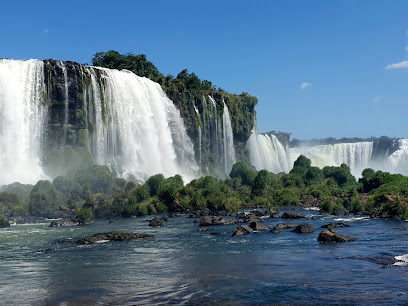
Iguaçu National Park
Discover the breathtaking beauty of Iguaçu National Park, home to majestic waterfalls and rich biodiversity in the heart of Brazil's Paraná state.

La Casa de Botellas
Experience the unique artistry of La Casa de Botellas in Iguazu, Argentina, where creativity meets sustainability in a mesmerizing recycled glass structure.

Paseos de Luna Llena en las Cataratas del Iguazú
Discover the enchantment of Iguazu Falls under the full moon—an unforgettable adventure in a breathtaking national park.

Iguazu National Park Nature Interpretation Center
Explore the Iguazu National Park Nature Interpretation Center for an unforgettable experience filled with stunning views and ecological insights in Argentina's lush rainforest.

Yryapu turismo guaraní
Explore the heart of Guaraní culture amidst the stunning landscapes of Puerto Iguazú at Yryapu Turismo Guaraní.
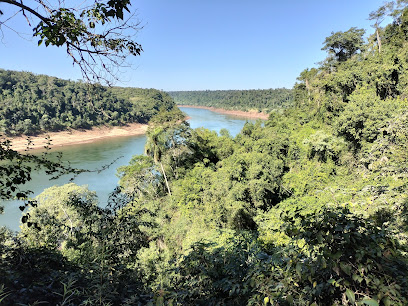
Salto Santa Maria
Explore Salto Santa Maria, a stunning waterfall in Misiones Province, Argentina, where nature's beauty and breathtaking views await every traveler.

Circuito Inferior
Experience the breathtaking beauty of Circuito Inferior, where nature's magnificence unfolds at Iguazu Falls, Argentina's iconic tourist attraction.

Iguazú National Park
Explore the breathtaking Iguazú National Park, home to stunning waterfalls, diverse wildlife, and lush rainforests in Argentina.

Bus turístico Iguazú
Discover the breathtaking Iguazú Falls and the surrounding wildlife with the convenient Bus Turístico Iguazú, your gateway to adventure in Puerto Iguazú.

Essential places to dine
Rafain Churrascaria Show
Experience authentic Brazilian barbecue with live performances at Rafain Churrascaria Show in Foz do Iguaçu.

Icebar Iguazú
Discover Icebar Iguazú: An unforgettable icy retreat offering unique cocktails and delicious cuisine in an enchanting frozen atmosphere.

El Quincho del Tio Querido
Experience authentic Argentine cuisine at El Quincho del Tio Querido in Puerto Iguazú—a culinary gem showcasing local flavors and warm hospitality.

Rafain Chopp
Discover Rafain Chopp in Foz do Iguaçu – where Brazilian flavors meet lively ambiance in a charming restaurant and bar.

Restaurante La Rueda
Experience authentic Argentine cuisine at Restaurante La Rueda in Puerto Iguazú—where every meal is a celebration of flavor and culture.

Aqva Restaurante Iguazú
Experience exquisite Argentine cuisine at Aqva Restaurante Iguazú, where every dish tells a story amidst breathtaking natural beauty.

Bendito - Bar e Restaurante
Discover Bendito - Bar e Restaurante in Foz do Iguaçu for an unforgettable taste of authentic Brazilian cuisine in a vibrant atmosphere.

Restaurante Porto Canoas
Experience authentic Brazilian flavors at Restaurante Porto Canoas near Iguaçu Falls – a must-visit buffet destination for every traveler.

La Mafia Tratoria
Experience authentic Italian cuisine at La Mafia Trattoria in Foz do Iguaçu - where flavor meets tradition in a cozy setting.

ParkFoz Steakhouse
Discover the taste of Brazil at ParkFoz Steakhouse, where succulent steaks and gourmet burgers meet a vibrant atmosphere in Foz do Iguaçu.

Bambu Restobar
Experience the vibrant flavors of Argentina at Bambu Restobar in Puerto Iguazú – where culinary delights meet warm hospitality.

Empório com Arte
Discover Empório com Arte: A vibrant bistro in Foz do Iguaçu blending local cuisine with artistic flair.

Bona - Gastronomia Italiana
Savor authentic Italian cuisine at Bona in Foz do Iguaçu – where every dish tells a story of tradition and flavor.

Park Falls Food
Experience diverse culinary delights at Park Falls Food - where flavors meet fun in Foz do Iguaçu's vibrant food court.
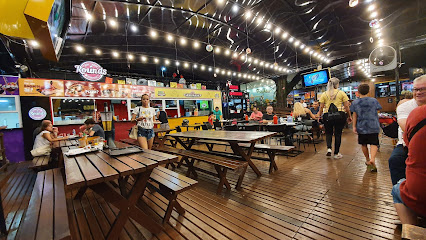
La Dama Juana Restaurant
Discover authentic Argentine cuisine at La Dama Juana Restaurant in Puerto Iguazú, where every dish tells a story of flavor and tradition.

Markets, malls and hidden boutiques
Hito Tres Fronteras
Explore the stunning Hito Tres Fronteras, a unique landmark where Argentina, Brazil, and Paraguay meet, offering breathtaking views and rich cultural experiences.

Duty Free Shop Puerto Iguazu
Discover unbeatable deals on luxury items at Duty Free Shop Puerto Iguazu, a shopping haven for tourists in Argentina.

Shopping Catuaí Palladium
Discover an expansive shopping experience at Shopping Catuaí Palladium, featuring diverse shops, delectable dining, and entertainment in Foz do Iguaçu.

Cataratas JL Shopping
Discover a world of shopping, dining, and entertainment at Cataratas JL Shopping, the premier mall in Foz do Iguaçu.

La Aripuca
Experience the beauty of nature at La Aripuca, an ecological park in Puerto Iguazú that combines environmental conservation with cultural richness.

Feirinha Puerto Iguazú
Experience the essence of Argentine culture and cuisine at Feirinha Puerto Iguazú, a lively market and restaurant in the heart of Puerto Iguazú.

Artesanato Chocolate Caseiro Três Fronteiras
Discover the rich flavors of Brazilian homemade chocolates at Artesanato Chocolate Caseiro Três Fronteiras in Foz do Iguaçu.
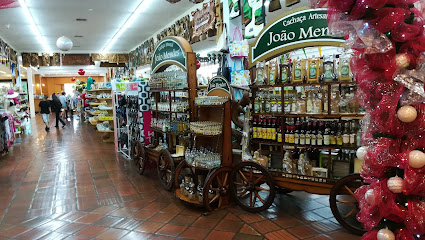
Paseos de Luna Llena en las Cataratas del Iguazú
Explore the enchanting Iguazu Falls by moonlight, a mesmerizing adventure that unveils the beauty of nature in a unique and serene setting.

Culturas Park Iguazu
Discover the vibrant cultural heritage at Culturas Park Iguazu, where nature meets tradition in a spectacular theme park experience.

Las Tres Fronteras
Experience the breathtaking views and rich biodiversity at Las Tres Fronteras, where Argentina, Brazil, and Paraguay meet in natural harmony.

Paseo Comercial Puerto Iguazú
Experience the vibrant culture and shopping delights at Paseo Comercial Puerto Iguazú, where local flavors and unique souvenirs await you.

Productores Mineros
Explore Productores Mineros, where the spirit of Puerto Iguazú comes alive through unique and handcrafted souvenirs that tell a story.

Iguazú National Park
Discover the stunning beauty of Iguazú National Park, home to breathtaking waterfalls and rich biodiversity in Argentina's lush rainforest.

Iguazú Timbó Arte
Explore Iguazú Timbó Arte for a vibrant selection of clothing that blends local artistry with contemporary fashion in the heart of Puerto Iguazú.

Punto Iguazú
Discover the ultimate shopping experience at Punto Iguazú, where local charm meets international flair in the heart of Puerto Iguazú.

Essential bars & hidden hideouts
Icebar Iguazú
Discover the magic of Icebar Iguazú, a unique bar and tourist attraction in Puerto Iguazú, Argentina, featuring stunning ice sculptures and cool drinks.
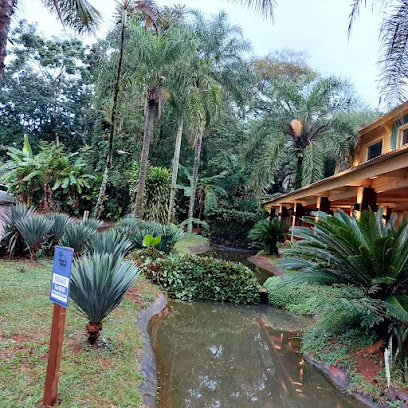
Capitão Bar - Restaurante Foz
Experience the vibrant flavors and lively atmosphere at Capitão Bar, the ultimate dining and nightlife destination in Foz do Iguaçu.

El Quincho del Tio Querido
Savor the authentic flavors of Argentina at El Quincho del Tio Querido, where every dish is a celebration of culinary excellence.

Rafain Chopp
Experience the vibrant flavors of Brazil at Rafain Chopp, the premier restaurant and bar in Foz do Iguaçu, where culinary delights await.

Dreams Ice Bar
Discover the frosty magic of Dreams Ice Bar in Foz do Iguaçu, where icy drinks and stunning sculptures create an unforgettable experience.
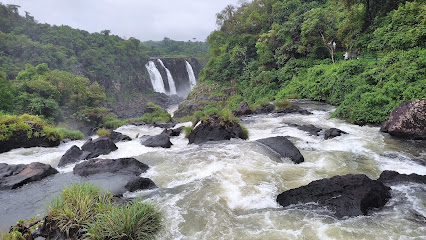
Holy Iguazú
Discover the flavors of Argentina at Holy Iguazú, a brewpub offering unique craft beers and delicious local cuisine in a vibrant atmosphere.

Aqva Restaurante Iguazú
Experience the best of Argentine cuisine at Aqva Restaurante Iguazú, where local flavors meet culinary excellence amidst stunning natural beauty.

Cerveza Patagonia - Refugio Iguazú
Experience the vibrant atmosphere and artisanal craft beers at Cerveza Patagonia in Puerto Iguazú, a true gem for beer lovers.

Bendito - Bar e Restaurante
Experience the vibrant flavors of Brazil at Bendito - Bar e Restaurante, a culinary oasis in Foz do Iguaçu offering authentic dishes and lively atmosphere.
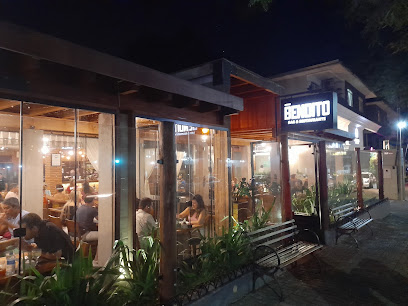
Quita Penas Resto Bar
Discover the vibrant flavors and lively atmosphere of Quita Penas Resto Bar in Puerto Iguazú, where local cuisine meets a festive nightlife.

Zeppelin Old Bar
Discover the vibrant nightlife at Zeppelin Old Bar in Foz do Iguaçu, where live music and delicious tapas create an unforgettable evening.
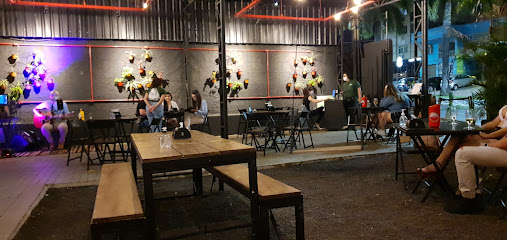
Nomen Nescio
Discover the vibrant atmosphere and local flavors at Nomen Nescio, Puerto Iguazú's premier bar and restaurant, perfect for unwinding after your adventures.

Park Falls Food
Experience the best of Brazilian and international flavors at Park Falls Food, a vibrant food court in Foz do Iguaçu.

Fortin Cataratas
Experience the taste of Argentina at Fortin Cataratas, a charming restaurant set in the majestic Iguazú National Park, perfect for travelers seeking local cuisine.

Humulus Speakeasy (bar restaurant pub)
Experience the perfect blend of culinary delights and vibrant nightlife at Humulus Speakeasy, Puerto Iguazú's top spot for food, drinks, and live music.

Local Phrases about Iguazu Falls National Park
-
- HelloOlá
[oh-lah] - GoodbyeAdeus
[ah-deh-oos] - YesSim
[seem] - NoNão
[nah-oo] - Please/You're welcomePor favor/De nada
[pohr fah-vohr/deh nah-dah] - Thank youObrigado/Obrigada
[oh-bree-gah-doo/oh-bree-gah-dah] - Excuse me/SorryCom licença/Desculpe
[kohm lee-sen-sah/dehs-kool-peh] - How are you?Como vai você?
[koh-moh vah-ee voh-seh] - Fine. And you?Bem. E você?
[behn. eh voh-seh] - Do you speak English?Você fala inglês?
[voh-seh fah-lah een-glehsh] - I don't understandEu não entendo
[eh-oo nah-oo ehn-tehn-doo]
- HelloOlá
-
- I'd like to see the menu, pleaseGostaria de ver o cardápio, por favor
[goh-stah-ree-ah deh vehr ooh kahr-dah-pee-oh, pohr fah-vohr] - I don't eat meatEu não como carne
[eh-oo nah-oo koh-moh kahr-neh] - Cheers!Saúde!
[sah-oo-deh] - I would like to pay, pleaseGostaria de pagar, por favor
[goh-stah-ree-ah deh pah-gahr, pohr fah-vohr]
- I'd like to see the menu, pleaseGostaria de ver o cardápio, por favor
-
- Help!Ajuda!
[ah-zhoo-dah] - Go away!Vá embora!
[vah ehm-boh-rah] - Call the Police!Chame a Polícia!
[shah-meh ah poh-lee-see-ah] - Call a doctor!Chame um médico!
[shah-meh oong meh-dee-koo] - I'm lostEstou perdido/perdida
[ehs-toh pehr-dee-doo/pehr-dee-dah] - I'm illEstou doente
[ehs-toh doo-ehn-teh]
- Help!Ajuda!
-
- I'd like to buy...Eu gostaria de comprar...
[eh-oo goh-stah-ree-ah deh kohm-prahr...] - I'm just lookingEstou só olhando
[ehs-toh soh oh-lahn-doo] - How much is it?Quanto custa?
[kwan-tooh koos-tah] - That's too expensiveIsso é muito caro
[ee-soh eh mwee-tooh kah-roo] - Can you lower the price?Você pode baixar o preço?
[voh-seh poh-deh bahy-shahr ooh preh-soh]
- I'd like to buy...Eu gostaria de comprar...
-
- What time is it?Que horas são?
[keh oh-rahz sah-oo] - It's one o'clockÉ uma hora
[eh oo-mah oh-rah] - Half past (10)Meio-dia
[may-oh dee-ah] - MorningManhã
[mahn-yah] - AfternoonTarde
[tahr-deh] - EveningNoite
[noy-chee] - YesterdayOntem
[ohn-tehm] - TodayHoje
[oh-zheh] - TomorrowAmanhã
[ah-mahn-yah] - 1Um
[oom] - 2Dois
[doh-ees] - 3Três
[trehs] - 4Quatro
[kwah-troh] - 5Cinco
[seeng-koh] - 6Seis
[say-ees] - 7Sete
[seh-teh] - 8Oito
[oy-toh] - 9Nove
[noh-veh] - 10Dez
[dehz]
- What time is it?Que horas são?
-
- Where's a/the...?Onde está o/a...?
[ohn-deh eh-stah oh/ah] - What's the address?Qual é o endereço?
[kwahl eh oh ehn-deh-reh-soh] - Can you show me (on the map)?Você pode me mostrar (no mapa)?
[voh-seh poh-deh meh moh-strahr (noh mah-pah)] - When's the next (bus)?Quando é o próximo (ônibus)?
[kwan-doo eh oh proh-ksih-moh (ohn-ee-boos)] - A ticket (to ....)Um bilhete (para ....)
[oom bee-lyeh-chee (pah-rah)]
- Where's a/the...?Onde está o/a...?
History of Iguazu Falls National Park
-
Long before European explorers set foot in South America, the Guarani people lived in harmony with the land surrounding Iguazu Falls. They called the falls 'Iguazú,' meaning 'big water' in their native language. The Guarani believed that the falls were a sacred site created by a deity named Mboi, a serpent god. The Guarani community's deep spiritual connection to the falls is still honored today, with several cultural preservation initiatives ongoing.
-
The first European to witness the breathtaking Iguazu Falls was the Spanish explorer Álvar Núñez Cabeza de Vaca in 1541. While leading an expedition in search of new territories, Cabeza de Vaca stumbled upon the falls and was awestruck by their magnificence. His accounts brought the falls to the attention of European explorers, marking the beginning of Western awareness of this natural wonder.
-
During the 17th and 18th centuries, the Jesuits established missions in the region, aiming to convert the indigenous Guarani people to Christianity. These missions played a significant role in shaping the history and culture of the area. Though the missions were eventually abandoned, their influence remains evident in the cultural landscape and historical narratives of the region.
-
In 1939, Brazil established Iguazu National Park to protect the natural beauty and biodiversity of the Iguazu Falls region. The park covers an expansive area of 1,700 square kilometers and is home to a diverse array of flora and fauna. The creation of the park marked a significant step in conservation efforts, ensuring that future generations could experience the majesty of Iguazu Falls.
-
In 1986, Iguazu National Park was designated as a UNESCO World Heritage Site. This recognition underscored the global significance of the park's natural beauty and ecological importance. The designation has helped to bolster conservation efforts and promote sustainable tourism, ensuring that the falls and their surrounding ecosystems are preserved for posterity.
-
Over the past few decades, Iguazu Falls National Park has become one of the most popular tourist destinations in South America. The Brazilian government has invested in infrastructure to accommodate the growing number of visitors, including viewing platforms, walking trails, and eco-friendly lodges. These developments have made the falls more accessible while prioritizing environmental sustainability.
Iguazu Falls National Park Essentials
-
Iguazu Falls National Park is located in the state of Paraná, Brazil. The nearest airport is Foz do Iguaçu/Cataratas International Airport (IGU), which is about 15 kilometers away from the park. From the airport, you can take a taxi, shuttle bus, or rent a car to reach the park. Alternatively, you can also fly into Cataratas del Iguazú International Airport (IGR) in Argentina and cross the border to reach the Brazilian side of the falls.
-
Once you are in Foz do Iguaçu, transportation to the park is straightforward. You can take a taxi, a local bus, or arrange for a hotel shuttle service. Public buses are an economical option and run regularly from the city center to the park entrance. Inside the park, there are eco-friendly buses that transport visitors between different attractions and viewing points.
-
The official currency in Brazil is the Brazilian Real (BRL). Credit and debit cards are widely accepted in hotels, restaurants, and shops in Foz do Iguaçu. However, it is advisable to carry some cash for smaller establishments or for purchases within the park. ATMs are available in the city, and some are located near the park entrance.
-
Iguazu Falls National Park is generally safe for tourists, but it is always advisable to take standard precautions. Be cautious of your belongings, especially in crowded areas and public transport. Avoid walking alone at night in unfamiliar areas of Foz do Iguaçu. While the park itself is well-patrolled and secure, the neighborhoods outside the immediate tourist zones can have higher crime rates. Stick to well-known routes and avoid isolated areas.
-
In case of emergency, dial 190 for police assistance and 192 for medical emergencies. The park has first aid stations and trained staff to handle minor injuries. For more serious medical issues, the nearest hospital is in Foz do Iguaçu. It is recommended to have travel insurance that covers medical emergencies. Make sure to carry a copy of your insurance policy and emergency contact numbers with you.
-
Fashion: Do wear comfortable and weather-appropriate clothing, including waterproof gear for the boat rides. Don’t wear high heels or flip-flops as the paths can be slippery. Religion: Do be respectful of local customs and traditions. Public Transport: Do be punctual and respectful to the bus drivers and fellow passengers. Don’t eat or drink on public transport. Greetings: Do greet people with a friendly 'Bom dia' (Good morning) or 'Boa tarde' (Good afternoon). Eating & Drinking: Do try local delicacies and accept hospitality graciously. Don’t litter in the park; always use the designated trash bins.
-
To experience Iguazu Falls National Park like a local, consider visiting during the shoulder seasons (April-May and September-October) to avoid the crowds. Take the time to explore the lesser-known trails and viewing points within the park. Engage with park guides and staff; they are knowledgeable and can offer unique insights about the flora and fauna. Don’t miss the opportunity to take a boat ride to get up close to the falls for a truly unforgettable experience.
Trending Landmarks in Iguazu Falls National Park
-
Iguazu Falls
-
Parque das Aves
-
Hito Tres Fronteras
-
Visitor Center Station
-
Lookout Devil's Throat
-
La Aripuca
-
Iguaçu National Park
-
Macuco Safari
-
Cataratas do Iguaçu - Brasil
-
Caminho das Cataratas Brasil
-
Bourbon Cataratas do Iguaçu Thermas Eco Resort
-
Hotel das Cataratas, A Belmond Hotel, Iguassu Falls
-
Paseos de Luna Llena en las Cataratas del Iguazú
-
Garganta Del Diablo
-
Parque Nacional do Iguaçu
Nearby Cities to Iguazu Falls National Park
-
Things To Do in Puerto Iguazú
-
Things To Do in Hernandarias
-
Things To Do in Villarrica
-
Things To Do in Encarnacion
-
Things To Do in Carmen del Parana
-
Things To Do in San Bernardino
-
Things To Do in Ypacarai
-
Things To Do in Aregua
-
Things To Do in Asuncion
-
Things To Do in Florianópolis
-
Things To Do in Tacuarembó
-
Things To Do in São Paulo
-
Things To Do in Fray Bentos
-
Things To Do in Maldonado
-
Things To Do in Punta del Este









